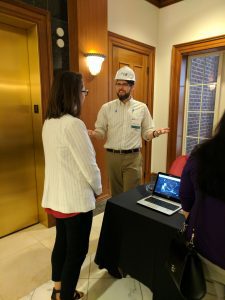 As educators, we typically teach lessons based on a set of pre-established standards. We cross our fingers, hoping that we are preparing students for a successful future. Some of us do not have a realistic view of what we are actually preparing our students for, and that is a problem. The Kenan Fellows Program for Teacher Leadership is the bridge that fills that knowledge divide. As a Kenan Fellow, I now know what I am preparing my students for, and that has changed everything for me.
As educators, we typically teach lessons based on a set of pre-established standards. We cross our fingers, hoping that we are preparing students for a successful future. Some of us do not have a realistic view of what we are actually preparing our students for, and that is a problem. The Kenan Fellows Program for Teacher Leadership is the bridge that fills that knowledge divide. As a Kenan Fellow, I now know what I am preparing my students for, and that has changed everything for me.
Through my internship this summer with Hyde Park Partners, I have learned that careers these days − no matter what − require certain skills. Members of the workforce need to be adept at communicating with others, organizing themselves, and thinking through problems critically and independently. From a front-lines warehouse worker to a big-picture boardroom executive, these skills are a requirement.
My takeaway is that I do not need to imagine that I am preparing my students for a specific job or career path. I am preparing my students to be well-informed members of society who could be ready for anything − and that is a good realization, because the workforce is a moving target. There is a multitude of career opportunities available for students including many that do not require a four-year college degree. Industry is becoming more automated. Workers need to be more technologically aware. Teachers need to adapt as well.
This experience has changed the way I approach my lessons. In the past, I used traditional units of study. If I were teaching about the moon, you could expect teacher directed lessons throughout the whole unit. Students would learn, and they would be assessed at the end. That would be it. Now I am setting the stage for each unit by framing it from the first day as part of a larger idea.
For our first unit of the school year, “Nutrition and Exercise,” I had a nutritionist who works with the Carolina Panthers come into the classroom and give my students a challenge. She told them that the Carolina Panthers are trying to start a flag football league for fourth graders. My students were tasked by this professional dietitian to create their own nutrition and exercise plans for kids their own age.
Are the panthers really recruiting the fourth grade students in my class to help them develop their youth football program? I could not tell you. A magician never reveals his secrets. The point is that now when my students come to class, they are not learning disparate chunks of information that I hope will coalesce into a full understanding of the subject. They are learning with a purpose. They are learning about nutrition and exercise so that they can immediately apply that knowledge towards completing an important project.
Some students adapted to the 21st century focused project-based learning approach beautifully, and they worked so hard to get their projects finished. Some students struggled with the personal responsibility inherent in applying their learning to a large project. They might let one aspect of the project fall to the wayside or miss a deadline or two. One major win I have noticed is that all of my students seem more excited about learning. Teaching students about nutrition has historically been a rather dry topic, but with the rationale of “working” for the Carolina Panthers, they were much more excited to learn.
Philip Carey is a 2017-18 Kenan Fellow who interned this summer with Hyde Park Partners. He teaches at Oakhurst STEAM Academy in Charlotte. Charlotte-Mecklenburg Schools and The Belk Foundation made his fellowship possible.